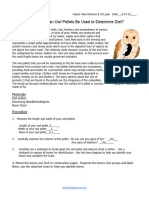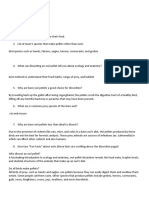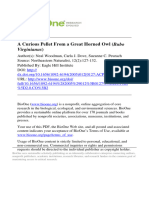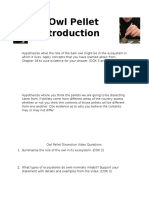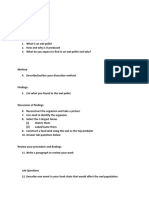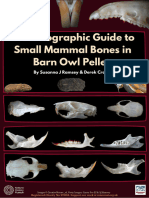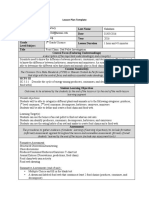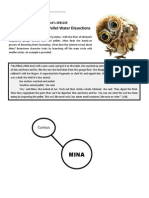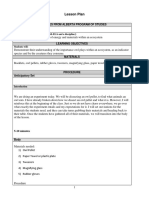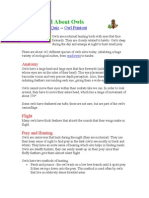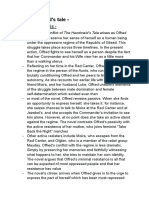Name:____________
Owl Pellet Dissection
Introduction:
Owl pellets provide important information to ornithologists about owl adaptations and habits. Scientists can
determine what owls are eating at various times and places by finding and dissecting owl pellets. Owl pellets also
provide information about the approximate numbers of prey animals in the owl's feeding area, which is valuable
information to scientists studying animal populations. Pellets are often found at the base of a perching tree.
Owls can digest only the soft muscles and organs of their prey. The bones, teeth, fur, feathers, scales, or
insect skeletons are too dense and cannot be converted into energy. The harder parts may also
puncture an owl's soft, curved intestines if passed through its digestive tract. Instead, the waste
material is formed into a pellet by the gizzard muscles and passed back up the esophagus to be cast out
(thrown up) about twelve hours later.
Although other birds, like eagles and hawks, also regurgitate pellets, owls are more efficient at it and
they regurgitate more frequently. Owls swallow their prey whole, ingesting the entire skeleton. Other raptors
selectively tear at their prey, eating only the soft digestible parts and leaving the indigestible bones. Also, unlike
other birds, owls do not have a crop, which is an organ that holds food until the stomach is ready to receive it. Other
species of raptors do not need to regurgitate pellets as frequently as owls because some of the food remains in the
crop, preventing food from passing up through the mouth for several hours.
Although pellets are waste material, they provide food and shelter for other organisms. Pellets sometimes provide
homes for clothes moths, carpet beetles, and fungi. You may find droppings, cocoons, or exoskeletons from these
animals in the pellets.
Prelab Questions: Read the introduction above and then answer the following questions
1. What information can scientists find with owl pellets?
2. Why can’t owls digests parts of animals like the claws, teeth, or feathers?
3. What muscles form the owl pellets?
4. Only owls regurgitate pellets. True/False. (circle one)
5. Besides being useful to scientists, how else are pellets used?
Procedure: Dissect the owl pellet provided following the instructions below.
1. Carefully unwrap the pellet on a clean working surface.
2. Inspect the pellet. In the space provided sketch a picture of the pellet, and write down any observations about
what you see.
3. Measure the length and width of your owl pellets.
Length of your owl pellet (cm)_______
Width of your owl pellet (cm)_______
Mass of your owl pellet (g)______
4. Carefully examine the exterior of the pellet. Do you see any signs of fur? _____ any signs of feathers? ____
�5. Very gently, pull apart the pellet. Be careful not to break any bones. (You may want to soak the pellet in a
beaker and some water to make finding parts easier – this is optional) – take special care removing skulls and
jaws as they are best way to identify the animals that the owl was eating. As you are pulling apart the owl pellet,
look for evidence of the wool eating moth life cycle – eggs, pupae casings, cocoons, or larvae – This will probably
be found in the hair – in the space below draw examples of any of the above mentioned parts that you see. Be
neat!
Roll out the last bits of fur between your fingers to find little bones or teeth that may have been overlooked.
5. As you are looking through your pellet, begin to fill out the table below.
Bones Found
Bone Number
Skull
Jaw
Scapula
Forelimb
Hindlimb
Pelvic Bone
Rib
Vertebrae
5 Lay out and try to reconstruct the skeleton(s) of the animal(s) you found in the pellet. Do this on the piece
of colored paper provided. Paste the parts onto the paper. Label the parts – Use the diagram below and
the bone sheet attached to assist you.
�Analysis
1. What do we know about the digestive system of an owl based upon the pellets?
2. Owl pellets not only can give us information about the diet of the owl, owl pellets also provide a habitat for other
animals, in fact an owl pellet is a little ecosystem all on its own. Why kind of animals are found in the owl pellet
ecosystem (Hint: read the background at the beginning)
3. Other types of birds form pellets. What would you expect to find in the pellet of a seagull?
4. Owls, hawks, and eagles are types of raptors, animals which have hooked beaks and sharp claws, and are
therefore adapted for seizing prey animals. Hawks and eagles differ from owls in that they eat their prey animals by
tearing them into small pieces, picking out the flesh and avoiding most of the fur and bones. They also have strong
stomachs which can digest most of the bone material which they might eat. The relatively small amount of
indigestible bone and fur that remain will be compacted by their stomach muscles into a pellet similar to the owl's.
Do you think an eagle pellet would be as useful for dissecting as an owl's? Why or why not?
5. Construct a diagram of a food web (of at least 5 animals) with an owl at the uppermost trophic level. Use an
arrow to show which organism in the consumer or predator
